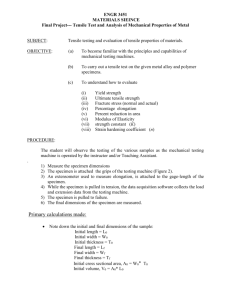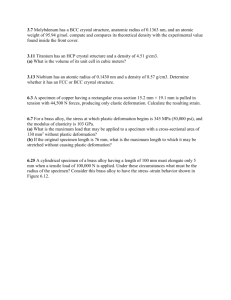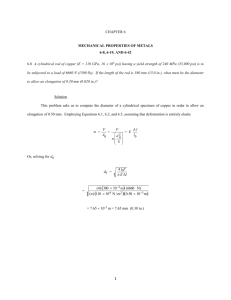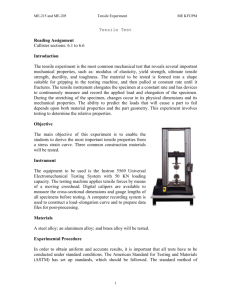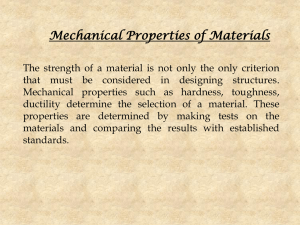Tensile Test - Department of Mechanical Engineering
advertisement
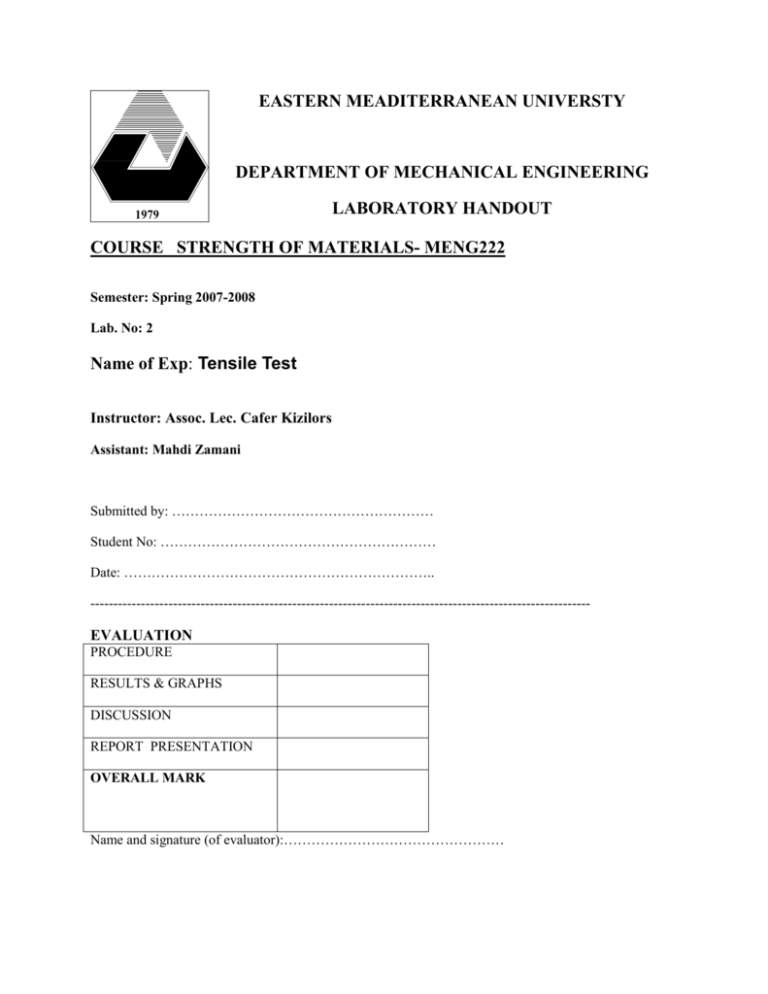
EASTERN MEADITERRANEAN UNIVERSTY DEPARTMENT OF MECHANICAL ENGINEERING 1979 LABORATORY HANDOUT COURSE STRENGTH OF MATERIALS- MENG222 Semester: Spring 2007-2008 Lab. No: 2 Name of Exp: Tensile Test Instructor: Assoc. Lec. Cafer Kizilors Assistant: Mahdi Zamani Submitted by: ………………………………………………… Student No: …………………………………………………… Date: ………………………………………………………….. ------------------------------------------------------------------------------------------------------------- EVALUATION PROCEDURE RESULTS & GRAPHS DISCUSSION REPORT PRESENTATION OVERALL MARK Name and signature (of evaluator):………………………………………… INTRODUCTION The tensile test is the most widely used test to determine the mechanical properties of materials. In this test, a piece of material is pulled until it fractures. During the test, the specimen elongation and applied load is measured. Strain and stress are calculated from these values, and are used to construct a stress-strain curve. From this curve, the elastic modulus and yield strength are determined. The highest load in the tensile test gives the tensile, or ultimate strength. After fracture, the final length and cross-sectional area of the specimen are used to calculate the percent elongation and percent reduction of area, respectively. These quantities indicate the ductility of the material. By using the instantaneous length and cross-sectional area, the true stress and true plastic strain are calculated from the load and elongation. The strain hardening properties of the material are then determined from a log-log plot of the true stress vs. the true plastic strain. Thus, from one test a large amount of information can be obtained about the mechanical properties of a material. In the lab, you will be testing two materials: a low carbon steel and a 70/30 brass (70% Cu and 30% Zn). Both these materials are in sheet form and a specimen typically used for testing sheet materials will be used (see Figure 1). The low carbon steel sheet is typically used in automobile bodies and appliance bodies. The 70/30 brass has a wide variety of uses. It may be cold worked to a fairly high strength level for screws and other hardware. In the annealed state, it has excellent formability and may be used for cartridge cases in ammunition or for lamp fixtures. (These are only some of the applications for these materials). You will be using a low capacity universal testing machine (1000 lbs). A sketch of how the machine operates is shown in Figure 2. You will be running the test at a constant displacement rate of the cross-head. You will be recording the displacement of the crosshead and the load on a strip-chart recorder. Since you will be using a micrometer in this lab, you will be expected to know how to read it. 33 EXPERIMENTAL PROCEDURES (1) For each specimen, measure the width, wo, and the thickness, to, using a micrometer. (2) Draw, with a pencil, two lines on the straight section of the specimen so that the lines are two inches apart. This will be the gage length, Lo. Figure1: Surface of the specimen (3) The testing machine has already been set up and calibrated by the lab assistant. (4) Put the specimen in the top grip and tighten it in place. (5) Put the specimen in the bottom grip and tighten it in place. Be careful not to bend the specimen while tightening. (6) The crosshead speed will be given to you by the assistant. Be sure to record it. (7) Start the test by pressing the “up” button. (8) After the specimen has broken, press the stop button. Then remove the two halves of the specimen. Figure2: Specimen mounted in jaws (9) Measure the final width of the specimen, wf, using the shadow-graph. (The shadowgraph uses a micrometer head that is divided into ten thousandths of an inch.) The final width is the minimum width which occurred at the neck. (10) Measure the final thickness of the specimen, tf, using a micrometer. The final thickness is the minimum thickness, which also occurs at the neck. This thickness is difficult to measure accurately. You may want to ask the lab assistant to help you measure this. Figure 1: Tensile Machine (11) Put the two halves of the broken specimen together and measure the distance between the lines that you scratched on the specimen. This distance is the final length, Lf. (12) Make a sketch of the failed brass specimen (sketch the flat side). Be sure to identify the neck and fracture regions. You may take the specimen with you and keep it. 34 (13) The lab assistant will show you a cylindrical tensile specimen that shows a typical cup and cone fracture. Examine this specimen in the stereo-microscope, and make a sketch of the fracture surface. Also, make a sketch of the side view of the specimen. ANALYSIS (1) Make a table giving the specimen, the original dimensions and the final dimensions. This will be Table I. (2) Construct a stress-strain curve from the load-elongation curve (a) First, make photocopies of your load-elongation curves. (b) Next, determine the origin of the load-elongation curves. The origin is at the intersection of the elastic loading line with the zero load line on the graph paper. (c) Choose a sufficient number of points on the load-elongation curve so that you can construct a smooth stress-strain curve. Mark these points on the load-elongation curve and number them. (d) For each point, compute the strain and stress (engineering values). Use percent strain as the unit for strain and Pa as the unit for stress. Be sure to show sample calculations. (e) Present these values in a table showing point number, load, elongation, stress and strain. This will be Table II. (f) Plot the data points of stress vs strain and draw a smooth curve through them. The stress is on the y-axis. Make two graphs. In the first graph, the strain should go from 0 to 2 percent. In the second graph, the strain should go from 0 to failure. Use standard graph paper, which is available at the bookstore or Excel (if you know how to use it). Engineering pad paper is NOT acceptable. (3) Using the first graph, where the strain goes to 2 percent, make the following calculations (and on the graphs, show how you made those calculations) (a) The elastic modulus of both samples. (The method of measuring elongation may lower your value of the elastic modulus by as much as 10 times. This is because the elongation measured includes the elongation of the testing machine, the grips, and the curved parts of the specimen as well as the straight part of the specimen.) 35 (b) The 0.2% offset yield strength of the brass. (c) The upper and lower yield strength of the steel. (4) Using the second graph, determine the tensile strength (also called ultimate strength). Be sure to show where this occurs on the graph. (5) Using your measurements of the specimen dimensions before and after the test, compute the percent reduction in area and the percent elongation. Be sure to show how you calculated these values with sample calculations. (6) Make another table containing the specimen, the elastic modulus, the yield strengths, the tensile strengths, the percent elongations and the percent reduction in areas. This will be Table III. (7) The engineering stress and strain values used above are not really the true values since they do not take into account that both the cross-sectional area, A, and the gage length, L, change during the test. The true stress and the true strain take these changes into account. The true stress and strain can be determined from the engineering stress and strain. (a) Derive the expressions by which you can calculate the true stress and strain from the engineering stress and strain. (b) Are these expressions valid for the entire tensile test? Why or why not? (8) Using the equations derived above, calculate the true stress and true strain for the steel specimen. Present the results in a table containing the engineering stress and strain and the true stress and strain. This will be Table IV. Be sure to show a sample calculation. (9) What is the true stress and strain at fracture for the steel specimen? Show the equations you used to calculate this. Include these values in Table IV. (10) Plot the true stress-strain curve for the steel specimen on a separate sheet of graph paper. Replot the engineering stress-strain curve for comparison. Make one just plot with strain going from 0 to fracture. The same guidelines apply as in 2(f). (11) Calculate the true plastic strain for the steel specimen. To do this, subtract the elastic part of the true strain from the true stain. (Use the elastic modulus you calculated previously since the same error is contained in both the strain and modulus numbers.) Include these 36 values in Table IV. Be sure to show a sample calculation. (Note that for small plastic strains, small measurement errors are of the same order of magnitude as the calculated plastic strain. This usually occurs for plastic strains below 0.1% and may result in calculating negative plastic strains.) (12) Plot the log of the true stress vs. the log of the true plastic strain. The true stress is the y-axis. You may do this by (i) computing the log of these quantities and then plotting the log values on linear graph paper, or (ii) using 1x3 cycle log-log paper available at the bookstore. Label your graph in psi and percent strain. (13) (a) Draw a smooth curve through the data in 11. Although this curve is expected to be a straight line, for many materials there is a pronounced curvature to it. (b) Compute the strain-hardening behavior of the steel from this plot. If there is curvature, use a straight section of the curve near the beginning of the data. The strain hardening behavior is commonly expressed by true stress = K * (true plastic strain)n where K is called the strength coefficient and n is called the strain hardening exponent. First, find n, which is the slope of the straight line. Then find K. Be sure to show the line you used on the plot and in your calculations. (14) Include your sketches of the fractured brass specimen and cylindrical specimen at this point. Identify the various features of the specimens. QUESTIONS (1) In the cup and cone fracture that you sketched, what causes the angled lip to form? (2) For the steel specimen, compare the engineering fracture stress, the true fracture stress and the tensile strength. Explain why these are the same or different. (3) What causes the yield point to drop in steel?
